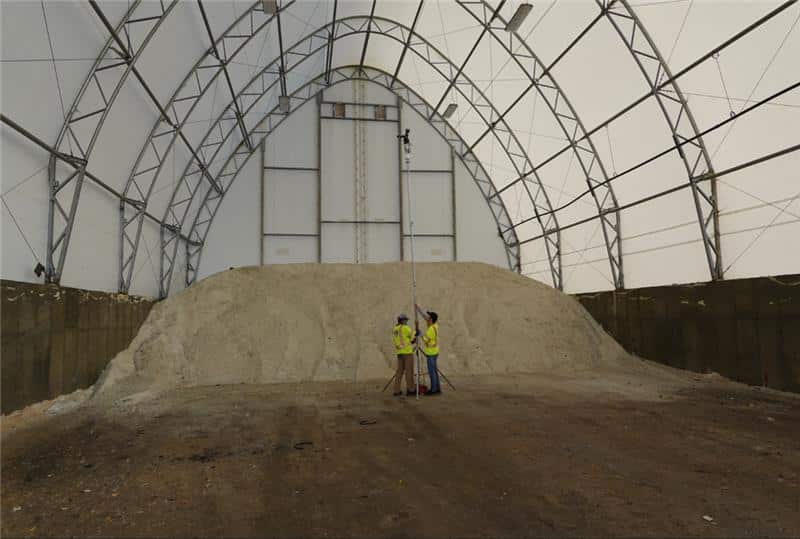INDOT, Purdue Partner Up to Measure Stockpiles
BY AsphaltPro Staff

Managing stockpiles of aggregates is a constant concern. That’s why the Indiana Department of Transportation (INDOT) funded research at Purdue University, West Lafayette, Indiana, into a fully automated, portable system to estimate the volume of stockpiles of bulk supplies known as SMART (stockpile monitoring and reporting technology).
Jeremy McGuffey, statewide winter operations manager for INDOT, said the catalyst behind INDOT’s investment into this research was to monitor the department’s nearly 120 salt storage buildings around the state, most of which visually estimate volume. However, he added, SMART can also be used to measure the state’s cold-mix asphalt and aggregate inventory.
“We’re guesstimating our inventory of those materials just as we do with salt,” McGuffey said. “If I pointed to a pile of stone on the ground, could another person accurately tell me the volume of that stone based on sight alone? SMART removes that guesswork.”
McGuffey said traditional methods to measure stockpiles use field survey procedures that last several hours and expose surveying crews to dangerous conditions. Although a few locations are equipped with survey equipment to take measurements based on the exterior size—the height and width—of the stockpile, those systems don’t account for depth.
Mesa Systems Co. Introduces HD2-Kit for Stockpile Moisture Management
“Many state DOTs have recognized the issues related to measuring stockpiles and have been looking for a more accurate way to measure the millions of dollars’ worth of materials they have stockpiled,” McGuffey said. SMART is INDOT’s attempt at a solution.
SMART was developed by Ayman Habib and Darcy Bullock, both from Purdue’s Lyles School of Civil Engineering. Habib and Bullock claim SMART is more precise, more cost-effective and safer than traditional commercial technologies to estimate the volume of stockpiles of bulk materials.
For example, although drones can be used for measuring volumes of outdoor stockpiles, they cannot be used for indoor stockpiles. “Particularly in buildings that block GPS signals used for navigation,” Habib said. Given that some producers opt to cover their stockpiles to minimize excessive moisture, a system like SMART could be an alternative solution for indoor stockpiles.
“SMART can be used for any type of stockpile,” Bullock said. “If you can put a pole up into the air and spin it around, SMART can build a 3D model of that stockpile and estimate the volume within a couple percentage points.”
The Future of Stockpile Inspections for the Aggregates Industry
The data collection process, Habib said, takes less than five minutes and relies on off-the-shelf technology to capture the data. SMART’s measurement tools include two low-cost light detection and ranging (LiDAR) units, a GoPro camera, a small computer known as a Raspberry pie and a 19-foot tripod.
The LiDAR system bounces light off the pile millions of times to collect the information needed to determine the volume, McGuffey said. After the measurement, it takes a few hours for SMART to process the data and calculate the stockpile’s volume.
“The technology estimates volume with less than 1% error in actual volume,” Habib said, adding that the nature of the stockpile material (including moisture content) does not impact the error percentage.
SMART can also create colorized point clouds that can be used as a visual record of the stockpile over time.
A paper about the SMART platform was published in the peer-reviewed journal Remote Sensing.
Get Results
McGuffey said SMART has already brought positive results to INDOT. “The biggest benefit has been the system’s accuracy,” he said. “One benefit I hadn’t realized before was the speed of the measurement process.” Another benefit, he added, is that the system is mostly automated.
McGuffey said INDOT first plans to utilize SMART at its salt storage facilities as they finish the research project with Purdue. “In terms of its use case in the aggregate space at INDOT, I think the mobility of the solution could make this an attractive way to measure outdoor stockpiles,” he said.
Although the mobility of the platform makes it a more flexible solution, Bullock and Habib said the next step is to package the system to be permanently mounted in storage facilities to allow for automated data collection. “The higher up the unit is, the better the measurements will be,” Habib said. “That’s why we’re planning for the system to be permanently installed at stockpile facilities.”
“Although it’s more cost effective to move one unit around, we believe this solution will be affordable enough to mount one unit per facility,” Bullock added.
“In the next few years, as the technology becomes more affordable, I could see these devices becoming even more cost effective,” McGuffey said.
The commercialization of the SMART platform remains a challenge for the private sector. “We’ve developed the technology,” Bullock said. “Now is where the private sector comes in. There are several groups now evaluating alternative business models to help us scale quickly.”
The Purdue Research Foundation Office of Technology Commercialization has applied for a patent for SMART from the U.S. Patent and Trademark Office. For information about licensing opportunities, contact Dhananjay Sewak of OTC at dsewak@prf.org about 2021-HABI-69512.
